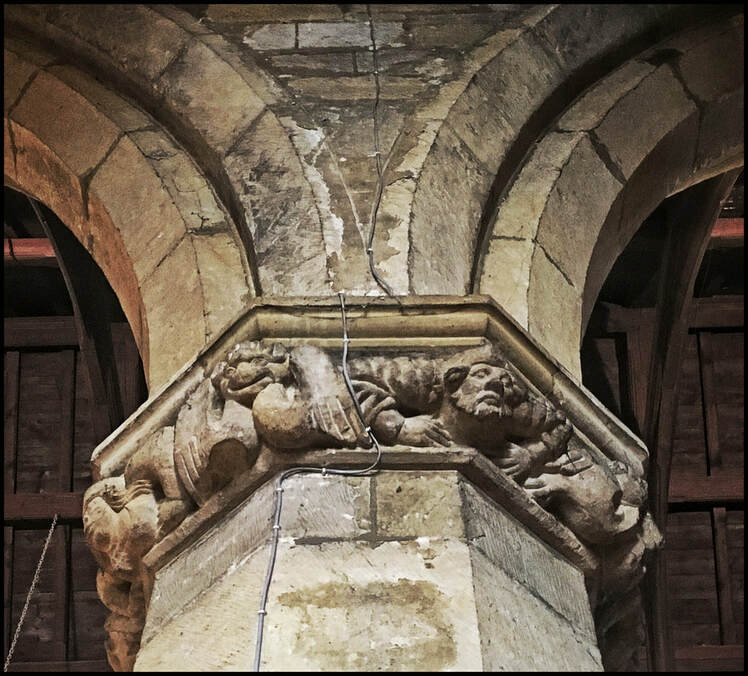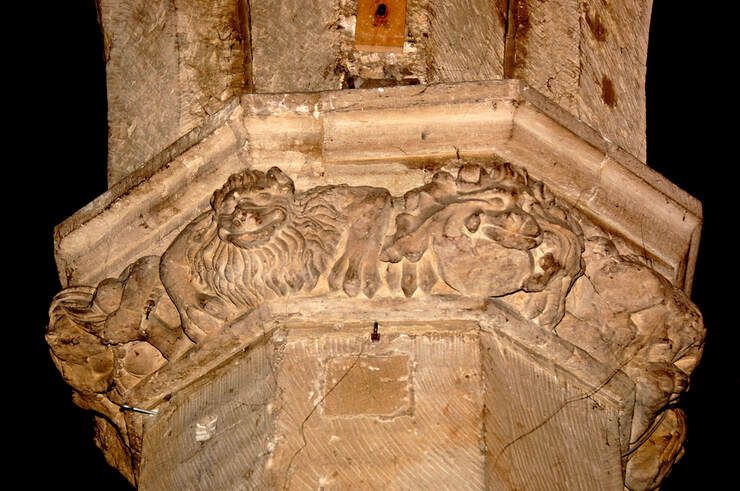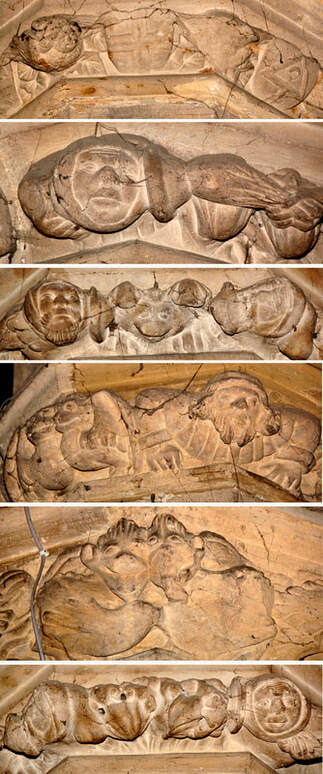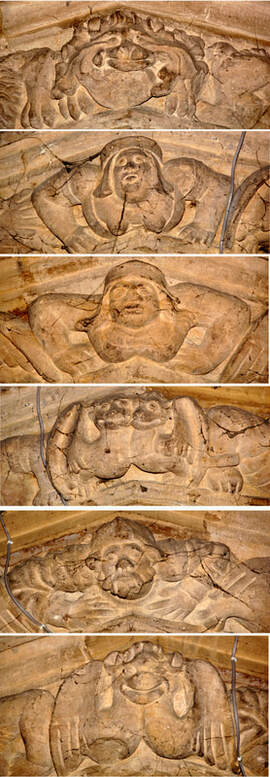The Four Pillars of St Thomas's
The Church of St Thomas the Martyr, with its two hospitals stood to the north side of the Old Bar on Newborough, near to the place where the Pancake Bell rings today. In its time this chapel was one of the most important buildings in town and the charity it provided was essential to the lives of Scarborough’s vulnerable people.
Founded in the 12th Century, St Thomas’s stood for five hundred years before being destroyed in the English Civil War.
The Order of Hermits of St Augustine ran St Thomas’s. They followed the Rule of St Augustine, a Christian theologian and philosopher from Numidia in North Africa. They observed the ancient custom of ringing a bell every morning and evening and it is the descendent of this bell that has become the Pancake Bell still rung today on Shrove Tuesday, the original bell being in the care of Scarborough Museum Trust.
Scarborough fell to the Parliamentarians on Shrove Tuesday 1645 and St Thomas’s was later demolished after sustaining irreparable damage during the castle siege.
In his book about Scarborough in the English Civil War, ‘Place of Great Importance’, the historian Jack Binns writes that all that remains of The Church of St Thomas “are a street name and a few pillars and stones now incorporated into St Mary’s church” , repairing the damage after the civil war.
Over four hundred years later the four octagonal pillars are still in situ on the St Nicholas Isle, aka The Fisherman’s Isle, inside St Mary’s Church. The pillars are very different to the victorian columns that can be seen on many of the 19th century buildings around Scarborough. The capitals for example are unique with carvings that are very unconventional and eccentric by today’s standards.
The carvings have the genuine wit and dark humour of the Middle Ages. Above each pillar are carved figures that have been given the illusion of being squeezed between the arches and the pillars that hold the weight of the church roof, like they’re being squeezed out like putty under the weight of the roof. I’m sure this is not accidental.
The carvings appear to be an assortment of miserable sinners being pressed too close for comfort next to ‘grotesques’ and ‘Chimeras’, imaginary beasts from the medieval imagination. During that era, the Pope had tasked sculptors to “preach in stone to the illiterate”. As well as depicting scenes from scripture, sculptors were encourage to illustrate the consequences of sin and they used their imaginations to shock the congregation. In the Medieval mind, monsters were supposed to be distorted humans, soulless, created far from God, stretching away in a direction of less and less reality. These creatures are physically and morally deprived, one step away from being a demon, but still retain a fragment of goodness and beauty to be present on a chapel’s masonry. More often than not, in this era these creative figures are expressions often mixed with dark humour. "Ful ofte in game a sooth I have herd saye!" (Many a true word is spoken in jest) said Chaucer in 1390.
The carvings on St Thomas’s pillars illustrate chimeras, strange birds and weird horned creatures all smiling oddly amongst the carvings of the tortured sinners, that are not only scared out of their wits, but also groaning under the weight of the holy church roof as it squeezes down on these poor souls, expunging their sin.
Anther name for these ugly beasts was a ‘Babewyn ’ an Old French Word for ‘baboons’ originally meaning a ‘grimace’. Incidentally, as I’ve mentioned the Civil War, Oliver Cromwell when he was just an infant, was kidnapped by his grandad’s baboon as the creature made for the roof. Cromwell was reportedly an ugly chap. To see both the infant Cromwell- future Lord Protector of The Commonwealth Of England in the arms of a baboon, up amongst the gargoyles on the roof, must have been an odd sight, but but I digress...
Many of the carvings on the pillars of St Thomas’s in St Mary’s have been damaged, but whether intentionally or by accident is not known. Some of these grotesque 14th Century carvings might have been a bit much for the congregation of St Mary’s in the 18th or 19th Century’s, when a gentler approach to worship was favoured over the abrasive humour of the Middle Ages, and perhaps a little ‘editing’ with hammer and chisel took place, to protect those with a more delicate demeanour?
I did read that grotesques and chimeras were only intended for the external walls of churches to illustrate how these damned creatures where unable to enter the holy space with, and they suffered a tortured existence that made them twisted and deformed, forever in purgatory, leaving them with a sickly grin. Perhaps these pillars may have originally stood at the entrance to St Thomas’s rather than the interior?
Many parish churches contain the most valuable parts of other churches that had fallen into disrepair. Much like an arc, or a storehouse of local culture and history. This is how grotesques and chimeras find there way into church interiors, they come to help repair and themselves be repaired, safeguarded and recognised as valid cultural objects welcomed into the chapel’s interior, under the church’s protection.
St Mary’s is a treasure house of historical items, an arc of Scarborough culture, housing meaningful objects important to the social history of the town.
There is another carving above the chancel of a bearded man and a buxom women who are struggling over a money bag. I’m not sure if all the carvings are related but there seems to be a definite theme of women exposing their breasts, men holding their own breasts and a baboon like grotesque with the largest breasts of all. I’m not sure if the vicinity around St Thomas’s either had semi-naked women causing anti-social behaviour, or the carvings were the result of a preoccupied stone mason.
davwhiteart.com
The Church of St Thomas the Martyr, with its two hospitals stood to the north side of the Old Bar on Newborough, near to the place where the Pancake Bell rings today. In its time this chapel was one of the most important buildings in town and the charity it provided was essential to the lives of Scarborough’s vulnerable people.
Founded in the 12th Century, St Thomas’s stood for five hundred years before being destroyed in the English Civil War.
The Order of Hermits of St Augustine ran St Thomas’s. They followed the Rule of St Augustine, a Christian theologian and philosopher from Numidia in North Africa. They observed the ancient custom of ringing a bell every morning and evening and it is the descendent of this bell that has become the Pancake Bell still rung today on Shrove Tuesday, the original bell being in the care of Scarborough Museum Trust.
Scarborough fell to the Parliamentarians on Shrove Tuesday 1645 and St Thomas’s was later demolished after sustaining irreparable damage during the castle siege.
In his book about Scarborough in the English Civil War, ‘Place of Great Importance’, the historian Jack Binns writes that all that remains of The Church of St Thomas “are a street name and a few pillars and stones now incorporated into St Mary’s church” , repairing the damage after the civil war.
Over four hundred years later the four octagonal pillars are still in situ on the St Nicholas Isle, aka The Fisherman’s Isle, inside St Mary’s Church. The pillars are very different to the victorian columns that can be seen on many of the 19th century buildings around Scarborough. The capitals for example are unique with carvings that are very unconventional and eccentric by today’s standards.
The carvings have the genuine wit and dark humour of the Middle Ages. Above each pillar are carved figures that have been given the illusion of being squeezed between the arches and the pillars that hold the weight of the church roof, like they’re being squeezed out like putty under the weight of the roof. I’m sure this is not accidental.
The carvings appear to be an assortment of miserable sinners being pressed too close for comfort next to ‘grotesques’ and ‘Chimeras’, imaginary beasts from the medieval imagination. During that era, the Pope had tasked sculptors to “preach in stone to the illiterate”. As well as depicting scenes from scripture, sculptors were encourage to illustrate the consequences of sin and they used their imaginations to shock the congregation. In the Medieval mind, monsters were supposed to be distorted humans, soulless, created far from God, stretching away in a direction of less and less reality. These creatures are physically and morally deprived, one step away from being a demon, but still retain a fragment of goodness and beauty to be present on a chapel’s masonry. More often than not, in this era these creative figures are expressions often mixed with dark humour. "Ful ofte in game a sooth I have herd saye!" (Many a true word is spoken in jest) said Chaucer in 1390.
The carvings on St Thomas’s pillars illustrate chimeras, strange birds and weird horned creatures all smiling oddly amongst the carvings of the tortured sinners, that are not only scared out of their wits, but also groaning under the weight of the holy church roof as it squeezes down on these poor souls, expunging their sin.
Anther name for these ugly beasts was a ‘Babewyn ’ an Old French Word for ‘baboons’ originally meaning a ‘grimace’. Incidentally, as I’ve mentioned the Civil War, Oliver Cromwell when he was just an infant, was kidnapped by his grandad’s baboon as the creature made for the roof. Cromwell was reportedly an ugly chap. To see both the infant Cromwell- future Lord Protector of The Commonwealth Of England in the arms of a baboon, up amongst the gargoyles on the roof, must have been an odd sight, but but I digress...
Many of the carvings on the pillars of St Thomas’s in St Mary’s have been damaged, but whether intentionally or by accident is not known. Some of these grotesque 14th Century carvings might have been a bit much for the congregation of St Mary’s in the 18th or 19th Century’s, when a gentler approach to worship was favoured over the abrasive humour of the Middle Ages, and perhaps a little ‘editing’ with hammer and chisel took place, to protect those with a more delicate demeanour?
I did read that grotesques and chimeras were only intended for the external walls of churches to illustrate how these damned creatures where unable to enter the holy space with, and they suffered a tortured existence that made them twisted and deformed, forever in purgatory, leaving them with a sickly grin. Perhaps these pillars may have originally stood at the entrance to St Thomas’s rather than the interior?
Many parish churches contain the most valuable parts of other churches that had fallen into disrepair. Much like an arc, or a storehouse of local culture and history. This is how grotesques and chimeras find there way into church interiors, they come to help repair and themselves be repaired, safeguarded and recognised as valid cultural objects welcomed into the chapel’s interior, under the church’s protection.
St Mary’s is a treasure house of historical items, an arc of Scarborough culture, housing meaningful objects important to the social history of the town.
There is another carving above the chancel of a bearded man and a buxom women who are struggling over a money bag. I’m not sure if all the carvings are related but there seems to be a definite theme of women exposing their breasts, men holding their own breasts and a baboon like grotesque with the largest breasts of all. I’m not sure if the vicinity around St Thomas’s either had semi-naked women causing anti-social behaviour, or the carvings were the result of a preoccupied stone mason.
davwhiteart.com
Grotesques on the St Thomas's Pillars in St Mary's Church Scarborough Photo by Dave Barry. Please Seek Permission before use.





